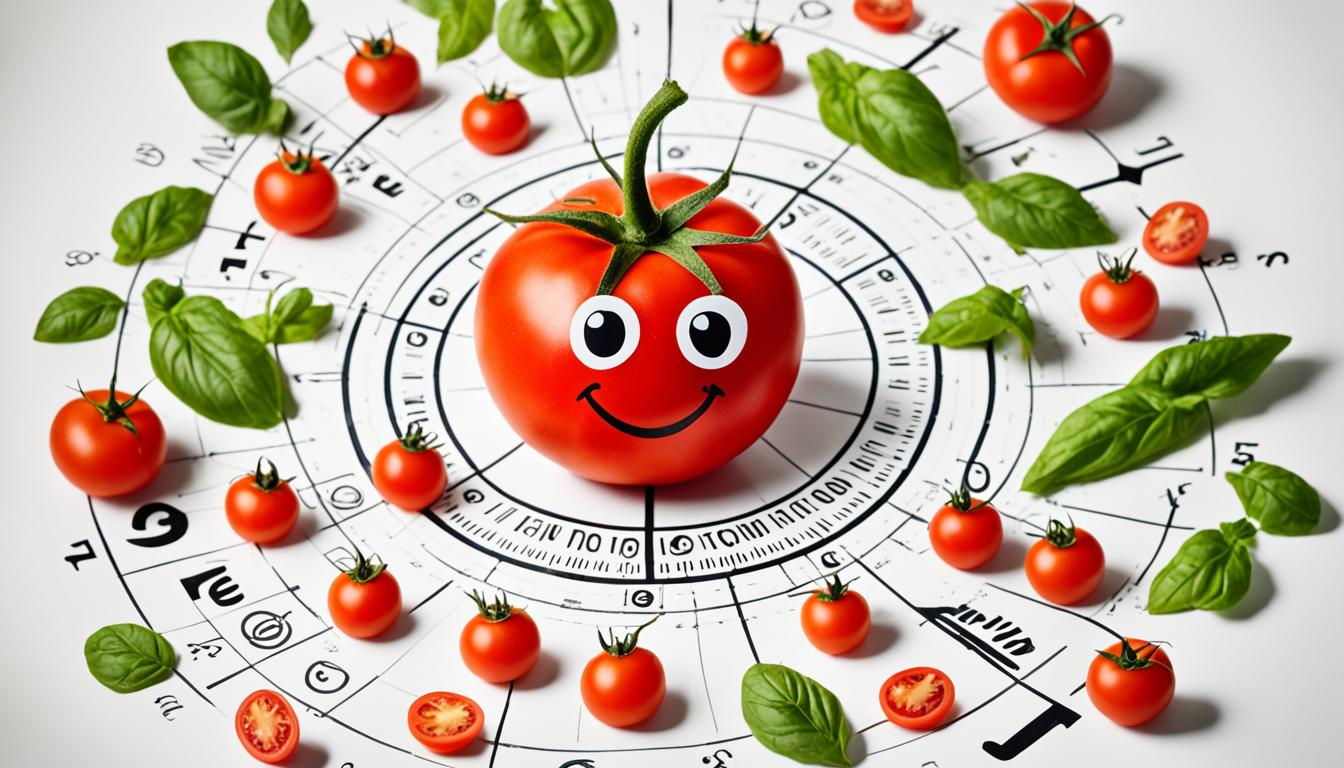Did you know people in America eat more than 30 pounds of tomatoes yearly? However, many people don’t know much about these fruits. They don’t always understand how to grow, ripen, and store them right.
Let’s clear up these tomato myths. This will help anyone who loves gardening or cooking get the most out of tomatoes. We will go over many myths about tomatoes. By the end, you’ll have all you need to grow tasty tomatoes yourself.
Key Takeaways
- Tomatoes are often considered a challenging plant to grow, but many of the perceived difficulties are myths.
- Understanding the truth behind common tomato myths can help gardeners achieve better yields and flavor.
- Dispelling misconceptions about tomato ripening, watering, and pruning can lead to more successful harvests.
- Recognizing the differences between heirloom and hybrid tomatoes can guide gardeners in making the best choices for their needs.
- Proper planting depth and techniques can significantly impact the health and productivity of tomato plants.
Introduction: Debunking Tomato Growing Misconceptions
Many myths surround growing tomatoes. People have their own special ways passed down through generations. This article aims to clear things up. It will show you that growing tomatoes can be easy and fun.
Gardening often comes with strange smells or practices. But, not all old tips are good. For example, too much paper as weed barriers can stop water and air. Remember, a little goes a long way with these methods.
Painting wounds on trees isn’t needed these days. It doesn’t help heal the tree, except for some special cases. Also, avoid too much digging in the soil. It can make it hard for water and roots to get through.
Too rich soil might mean more leaves than flowers on pepper plants. However, this doesn’t stop them from bearing fruit. If your plant isn’t flowering, it could be the weather. Hot, dry winds can make flowers fall off.
Wood chips around plants can be too moist for some, like cactuses. This moist environment can also attract bugs and cause rot. Use wood chips lightly and keep them from touching plant stems.
Leaving grass clippings actually helps your lawn. It adds free nitrogen and reduces your work. Watering plants every day is not needed, except for those in pots. But, water landscape plants deeply to make strong roots.
Coffee grounds contain important nutrients, but they release them slowly. They may not be quick enough for tomatoes when they need it most. Also, the caffeine in coffee grounds can disturb the balance of the soil. This might not be good for all plants around, even though tomatoes are alright with it.
If you use coffee grounds in your garden, mix them with other organic matter. This balance is important for the soil’s health and the growth of your plants.
Coffee grounds are not always as acidic as we think. Yet, checking your soil’s pH is crucial before adding them. This will ensure your tomatoes can get the nutrients they need from the ground.
The idea that coffee grounds keep pests away isn’t backed by science. In fact, coffee grounds can sometimes attract pests and lead to mold. This mold could hurt your tomato plants and the life in the soil. Composting the grounds first can avoid this issue.
Many organic and natural methods are available for pest control in vegetable gardening.”
You can grow a vegetable garden in small places. It’s a bit of work but can be quite simple with a plan. Urban gardening and using containers both work well. Starting with seedlings can make things easier.
Veggie gardening is fun for anyone with some how-to guides and online help. Different veggies like different weather. So, pay attention to their needs. Deep, less often water is best for strong roots.
Good insects, like bees, are helpful in the garden. They help plants grow by moving pollen. Organic farming is a great way to grow veggies without harming the environment. Plus, it keeps the earth healthy for future harvesting.
Common Tomato Myths
Tomatoes are a top choice for gardens. But they face many myths. Let’s look into some of these and find the real facts.
Myth: Tomato Seedlings are Fragile
Many think tomato seedlings are fragile, but that’s not true. Originally, they were weeds in South America. They are tougher than most people realize.
You can plant them deep without worry. They grow more roots along the stem. This makes them stronger.
Myth: The More Sun, the Better for Tomatoes
It’s believed that tomatoes need lots of sun to grow well. While this is true for some, most need just 6-8 hours of sun. Growing them north to south helps protect them from too much sun.
Some tomato types do better with less sun, especially during the hottest hours. Too much sun can harm the plants. This may lower the number or quality of fruit they produce.
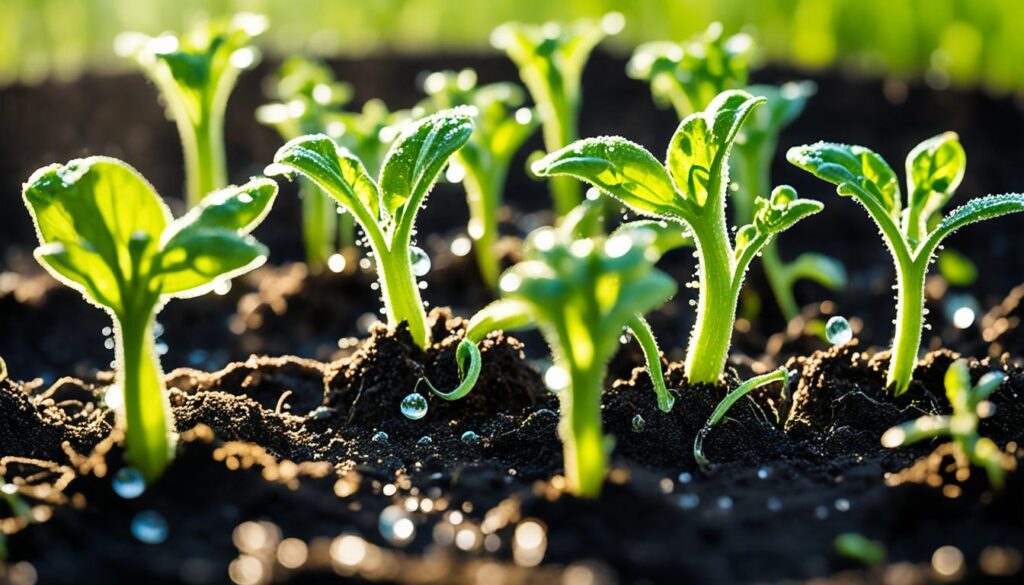
“Tomatoes are much hardier than they are often given credit for. Gardeners can bury tomato seedlings deep without needing to coddle them.
| Myth | Fact |
|---|---|
| Tomato seedlings are fragile | Tomato seedlings are actually quite hardy and can be planted deeply without issue. |
| Tomatoes need maximum sun exposure | Most tomato varieties only require 6-8 hours of direct sunlight per day, and some even prefer partial shade. |
Growing Tomatoes in Containers vs. Ground
Many gardeners think about which way is best to grow tomatoes. Growing them in containers or in the ground both have good outcomes. But, there are differences to keep in mind.
Myth: Growing Tomatoes in Pots is the Same as Growing Them in the Ground
Some people think they are the same, but that’s not true. The soil in containers gets warmer faster. This can make tomatoes ripen two weeks earlier in pots than in the ground.
This is great for places that are cooler. But, you’ll need to water and fertilize more. Pots dry out quicker than the ground, so they need extra care.
Also, big tomatoes might not do well in pots. Smaller kinds usually have more success. Think about what your tomatoes need before choosing how to grow them. This will help you decide on containers or the ground.
| Tomato Growing in Containers | Tomato Growing in Ground |
|---|---|
| Soil warms up faster, allowing earlier ripening | Soil warms up more slowly, but can produce exceptionally heavy yields |
| Requires more frequent watering and fertilizing | Provides excellent drainage in raised beds |
| Smaller, short-season varieties often do better | Larger, beefsteak varieties can thrive |
| Offers versatility in planting locations | Allows for flexibility in crop rotation and companion planting |
Deciding between pots or the ground depends on your climate and space. Think about what you prefer when gardening. Both ways can give you tasty tomatoes with the right care.
Tomato Varieties and Their Uses
Many believe only paste tomatoes, like ‘Roma’, are good for sauces. This myth is not true. Any flavorful tomato can work well for making sauce, not just ‘Roma.
Some varieties, like heirlooms or cherries, might need longer to cook to a sauce. They also have thin skins. But, their taste is often better than traditional paste tomatoes.
Tomatoes can be red, orange, yellow, brown, green, purple, pink, burgundy, and even striped. No matter the color, tomatoes have lycopene, a super antioxidant.
The tomato industry has grown a lot lately. Now, we can get tomatoes all year because of greenhouses. There are thousands of tomato types to meet different needs and climates.
Myth: Use Only Paste Tomatoes for Sauce
Though ‘Roma’ tomatoes are often used for sauce, other types are also great. Heirloom and cherry tomatoes can add a unique, delicious flavor to sauces as well.
The tomato world is vast and diverse. Tomatoes are grown worldwide, with over 150 million tons a year. Leading producers are China, the U.S., and India.
In the European Union, some tomato places have a special protected status. For example, Pomodoro di Pachino in Sicily and Tomaten von der Insel Reichenau in Germany. This shows how special tomatoes are.
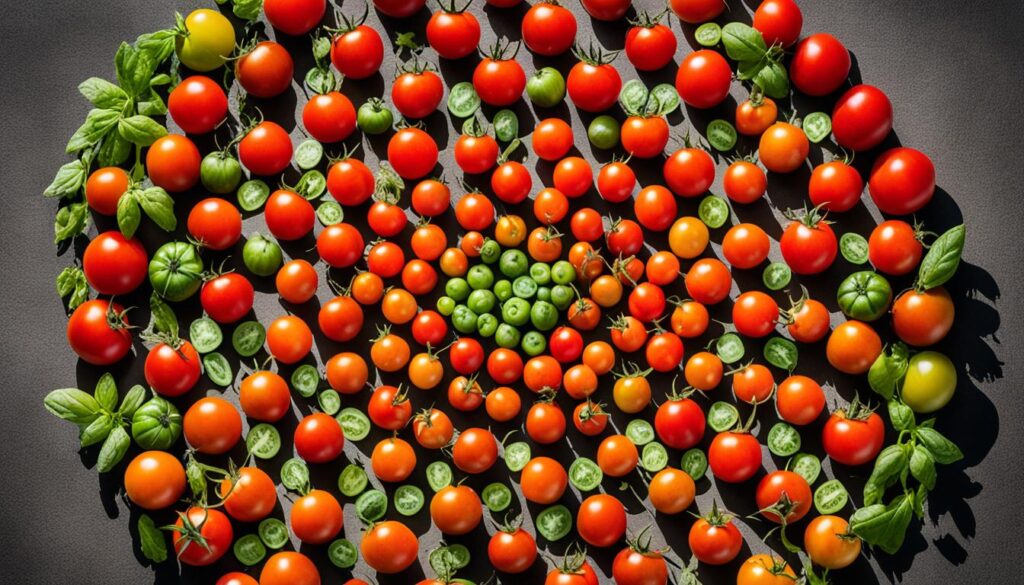
Don’t stick with just one kind of tomato for sauce. Try different types to find your favorite taste.
“Tomatoes, despite common belief, are technically classified as fruits due to their seed-bearing nature.”
Watering and Fertilizing Tomato Plants
Tomatoes do not need heavy watering all the time. Too much water can harm the plants and cause diseases. It’s best to water them deeply but not too often, every 4-5 days. This lets the soil dry out a bit between waterings. You might need to water more as the plant grows.
Some think yellow leaves mean the plant needs more food. Actually, it’s just a natural thing the plant does. If your soil is good, your plants usually don’t need a lot of extra food to do well.
Myth: Tomatoes Need Lots and Lots of Water
Tomatoes should be watered deeply but not too often. Too much water can make them sick and isn’t good for their health. Water them every 4-5 days. Let the soil dry out slightly between waterings. As they grow, you might need to water them more.
Myth: When the Leaves Turn Yellow, Fertilize
Yellow leaves are normal for tomatoes. They don’t always mean the plant needs more food. If your soil is rich with organic matter, your plants should be fine. They usually don’t need lots of extra food to grow well and give you plenty of tomatoes.
| Fertilizer Type | NPK Ratio |
|---|---|
| Fertilizer A | 18-18-21 |
| Fertilizer B | 3-4-6 |
| Fertilizer C | 3-6-4 |
This article looks at three different tomato fertilizers with different nutrient mixes. The US extension offices give advice on how much nitrogen tomatoes need. They think tomatoes do best with lots of nitrogen, more than most products suggest. High nitrogen can make tomatoes grow better. But, people often use too much fertilizer, and sometimes they measure it wrong.
Consistently soggy soil can actually encourage diseases and negatively impact tomato plant health.
To care for tomatoes, don’t water them too much, and don’t worry about yellow leaves meaning they’re hungry. Knowing these tips and caring for your tomatoes the right way will help you grow lots of healthy tomatoes.
Pruning Tomato Plants for Better Yields
Growing tomatoes brings up the topic of pruning. Many think it’s crucial for big results. But, pruning too much can drop tomato production by 33% rather than not pruning at all.
Still, pruning does have its good sides. It can make the plant healthier by enhancing air flow. This cuts down on bugs and sicknesses. Plus, it helps the plant grow bigger and better tomatoes. Yet, remember, you might get fewer tomatoes in total.
Choosing to prune is really up to you and your garden’s setting. The choice is between big, wild plants with many small tomatoes or neat plants with fewer but bigger fruits. The ideal choice depends on space, weather, and what you plan to do with the tomatoes.
The Pros and Cons of Tomato Pruning
One big plus of pruning is better air movement around the plant. This means less chance of disease or bugs. Yet, remember, you might not get as many tomatoes. Leaving side stems on tomato plants can double the fruit production, but they’ll be a little smaller.
Pruning can also be risky because it creates open cuts that might catch diseases. You can avoid this by not pruning the side stems. Remember, not pruning means less work but maybe fewer tomatoes. This might help you decide which way to go.
| Pruning Tomato Plants | Leaving Tomato Plants Unpruned |
|---|---|
| – Improves air circulation, potentially reducing pests and diseases | – Produces around twice as many fruits, though slightly smaller in size |
| – Can result in larger, higher-quality fruits | – Avoids the risk of exposing the plant to harmful microbes through pruning wounds |
| – Reduces overall yield by around 33% | – Requires less time and effort compared to pruning |
The big question is, to prune or not? It’s all about what you prefer and your garden’s setup. Think about what matters most to you, and weigh the plus and minuses to decide what’s best for your garden. Like many garden choices, there isn’t just one perfect answer.
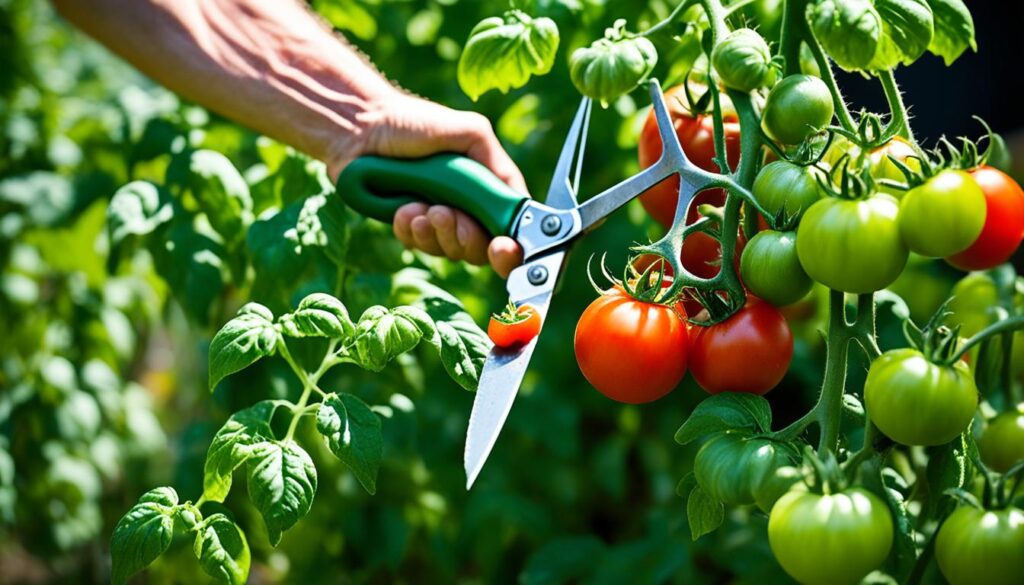
“Pruning tomato plants might reduce yield by 33%, but it can also decrease pests and diseases by enhancing air flow around the plants.”
In the end, it’s all about what you as the gardener want. Think about the benefits and drawbacks of each method. This will help you make a choice that fits your goals and what’s important to you.
Ripening and Harvesting Tomatoes
There’s a myth about ripe tomatoes, suggesting they must be red. This is not entirely true. A tomato is perfect when it shows its true color, such as red or yellow. Also, it should be a bit soft. This is when it tastes the best because the acids and sugars are perfect.
To avoid pests, you can pick tomatoes when they start showing color. Then, let them ripen in a cool, dark place. This method keeps your tomatoes safe from harm. At the same time, they still become sweet and delicious.
The Importance of Tomato Ripening and Harvesting
Knowing how to ripen and pick tomatoes is key for great results with your crop. Wrong info on this can harm your plants and affect your harvest.
Picking tomatoes at the right time improves their taste. Also, taking care when storing them helps keep their flavor longer.
By learning the truth about tomato ripening, you can make the most of this fruit. A bit of knowledge and care ensures top-quality tomatoes.
| Tomato Ripening and Harvesting Facts | Value |
|---|---|
| Most tomatoes need 6-8 hours of full sun per day | |
| Soil in containers warms up faster, allowing tomatoes to ripen 2 weeks earlier | |
| Ideal watering frequency for tomatoes is every 4-5 days | |
| Tomatoes in good soil don’t need aggressive fertilizing | |
| Tomatoes are ripe when they’ve reached true color and are softening | |
| Planting seedlings with 3-4 inches above soil ensures sturdier growth |
Understanding tomato ripening and harvesting helps gardeners enjoy excellent flavor. Do it right and enjoy delicious, homegrown tomatoes.
Proper Planting Depth for Tomato Seedlings
Planting tomato seedlings right is a key part of successful gardening. If they’re planted too shallow, they might grow weak and small. But if they’re buried too deep, the plants might not get enough sunlight and air. The right depth helps tomatoes grow strong and healthy.
It’s best to plant tomatoes so 3-4 inches of the stem are above the soil. This way, the extra stem can turn into roots, making the plant sturdier. You can also try planting the seedling sideways with the top part sticking out of the soil. Both ways help the plant make a good root system for water and food.
The right tomato planting depth matters for both early and later plant growth. Planting deeper helps the roots reach deep for water, which helps the plant grow well. It’s also important to support the plants as they grow, so use canes or planters with supports. This stops the plants from being damaged by the wind.
Following these tips for tomato seedling care and tomato root development will help you grow great tomatoes. With the right transplanting and care, plus good soil, your plants should do very well.
“Planting tomato seeds too early is a common mistake made by new gardeners, leading to weak plants due to lack of warmth and light.”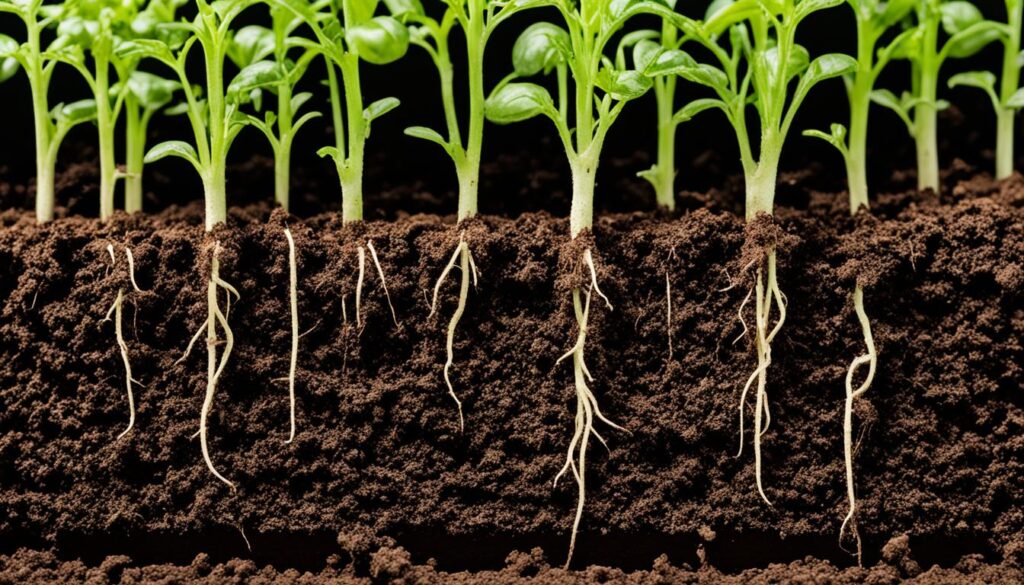
| Planting Depth Recommendations | Advantages | Disadvantages |
|---|---|---|
| 3-4 inches above soil surface |
|
|
| Planting on its side, 3-4 inches exposed |
|
|
By following these best practices for tomato planting depth, gardeners can give their tomato seedlings the best possible start, leading to a thriving and productive crop. Proper tomato seedling care and tomato root development techniques, combined with ongoing support and maintenance, will ensure your tomato plants reach their full potential.
Heirloom vs. Hybrid Tomatoes: Understanding the Differences
I love tomatoes and often wonder about heirloom and hybrid types. Each kind has its own benefits. Knowing about these differences helps gardeners choose the best for their tomatoes.
Heirloom tomatoes are special. They are not crossbred and have a history of at least 40 years. They stand out for their amazing taste, bright colors, and unique shapes. Yet, they might be harder to grow because they can get sick more easily.
Hybrid tomatoes come from crossing two different types. This mix aims to get the best qualities, like more tomatoes sooner, and less sickness. They might not taste as rich as heirlooms, but they’re usually easier to care for and give a steady crop.
All tomatoes are a bit sour, with an acidity level of about 4.3. But, their sweetness can vary based on the tomato’s genes.
People are also trying something new with tomatoes. They’re grafting them, making stronger and healthier plants that might fight off sickness better. Yet, these grafted plants don’t seem to do much better than regular ones in studies.
The choice between heirloom and hybrid tomatoes depends on what you like and need. Think about taste, looks, health, and how many you want. This way, you can have a great tomato garden that fits what you’re looking for.
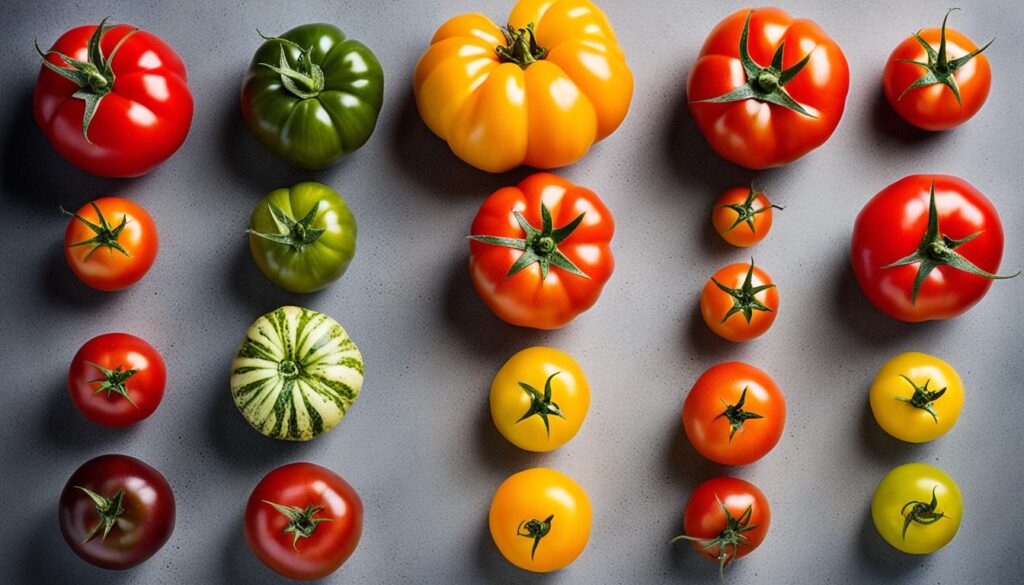
“Heirloom tomatoes stand out for their amazing taste, while hybrids are made for special qualities like fighting off diseases and giving lots of tomatoes.”
Choosing between heirloom and hybrid tomatoes is about what you love and where you’re growing them. You might pick rich-flavored heirlooms or hardy hybrids. The fun of growing and eating homegrown tomatoes is something everyone can enjoy.
Conclusion
Growing tomatoes can be rewarding and fun. But, there are many myths. They are about caring for seedlings, the best sunlight, using containers, picking the right type, how much to water, what food to give, how to prune, and when tomatoes ripen.
Tomatoes are part of the Solanaceae family. This family also has tomatillos, potatoes, eggplants, and peppers. The tomato plant creates tomatine, a chemical in its green parts. This includes its leaves and green tomatoes. But, tomatine is not really dangerous for people. You would need to eat a lot of tomato leaves, more than a pound, to be harmed.
To succeed in growing tomatoes, knowing the right information is key. This helps in having healthier plants and tastier fruits. It also makes the whole tomato growing process more exciting. Learning about the best light, temperature, and care is crucial. It can make a big difference, whether you’re using pots or planting in the garden.
FAQ about Common Tomato Myths
Are tomato seedlings really as fragile as they are often portrayed?
Tomato seedlings are not as fragile as believed. They come from South America, where they grew without care. In fact, you can plant them deep without worry.
Do tomatoes really need maximum sun exposure to thrive?
Tomatoes need a lot of sun, but not as much as you might think. They do well with 6-8 hours of sunlight each day. Putting them in rows that face north to south can help them avoid getting too much sun.
Is growing tomatoes in containers the same as growing them in the ground?
Growing in containers is quite different from the ground. It makes tomatoes ripen sooner. But, it means more work such as frequent watering and feeding.
Bigger tomatoes may not do as well in pots. But, smaller ones do great. They need less time to grow.
Can only paste tomatoes be used for making tomato sauce?
Not at all. You can use any tomato to make sauce. Although ‘Roma’ tomatoes are popular for sauce making, all types work well. More watery tomatoes need more time to cook down, but taste better.
Do tomato plants really need constant, heavy watering?
Tomatoes don’t need water all the time. Too much water can hurt them. Water deeply every 4-5 days instead of every day.
The plant may need more water as it grows. Let the soil dry a bit between each watering.
Should I fertilize my tomato plants when the leaves start to yellow?
Yellow leaves don’t always mean they need food. Good soil usually has what the tomato needs. Only add nutrients if the soil lacks them.
Is pruning essential for growing great tomatoes?
Pruning is not a must for tasty tomatoes. In fact, cutting them back too much can lower your tomato amount.
But, it can stop sickness and let more air in.
Are tomatoes ripe when they turn red?
No, tomatoes change color before they are ripe. Fruit is ready when it gets its full color and softens a bit. This way, they taste just right.
How deep should I plant my tomato seedlings?
To plant seedlings well, bury them up to 3-4 inches. This helps their roots grow strong. You can also lay the plant down, with its top out of the soil.
What are the differences between heirloom and hybrid tomatoes?
Heirloom tomatoes are natural and taste good. But they might get sick easily. Hybrids are made by people for certain features. Yet, seeds from hybrids might not grow the same.
Choose based on what you like and where you grow tomatoes.
Source Links
- https://www.tulsamastergardeners.org/blog/Entries/2021/6/tomato-garden-myths.html
- https://www.today.com/news/tomato-myths-still-sow-many-seeds-confusion-wbna44089060
- https://www.birdsandblooms.com/gardening/gardening-basics/garden-myths/
- https://meadowlarkjournal.com/blog/are-coffee-grounds-good-for-tomato-plants
- https://medium.com/gardening-birding-and-outdoor-adventure/debunking-common-gardening-myths-b1d123f2d7cb
- https://www.naturefresh.ca/debunking-the-most-common-tomato-myths/
- https://www.ruralsprout.com/tomato-growing-myths/
- https://www.augustachronicle.com/story/lifestyle/home-garden/2011/08/11/tomato-myths-sow-seeds-confusion/14529565007/
- https://www.bonnieplants.com/blogs/garden-fundamentals/9-ways-to-grow-tomatoes
- https://www.hortidaily.com/article/9252034/tomato-myths-unravelled/
- https://horticultureandsoilscience.fandom.com/wiki/Tomato
- https://www.gardenmyths.com/how-to-fertilize-tomato-plants/
- https://www.tomatofest.com/common_tomato_problems_s/118.htm
- https://marinmg.ucanr.edu/BASICS/GARDEN_MYTHS_BUSTED/
- https://www.gardenmyths.com/should-you-prune-suckers-on-tomatoes/
- https://laidbackgardener.blog/2017/07/08/the-truth-about-tomato-suckers/
- https://manningcommunitynews.com/2018/10/tomato-myths/
- https://www.finegardening.com/project-guides/fruits-and-vegetables/the-truth-behind-8-tomato-myths
- https://www.epicgardening.com/tomato-myths/
- https://www.gardenmyths.com/myths-ripening-tomatoes/
- https://www.haxnicks.co.uk/blogs/grow-at-home/tomato-growing-mistakes
- https://www.almanac.com/10-secrets-growing-tomatoes
- https://www.tomatofest.com/tomato_seeds_how_to_seed_starting_instructions_s/116.htm
- https://www.kqed.org/quest/24249/tomatoes-heirlooms-vs-hybrids
- https://medium.com/@beingonearth/heirloom-vs-hybrid-tomatoes-76715823ca1e
- https://gardenbetty.com/tomato-leaves-the-toxic-myth/
- https://www.gardenmyths.com/myth-is-born-tomato-ripening/
- https://joegardener.com/podcast/tomato-seedling-mistakes/
